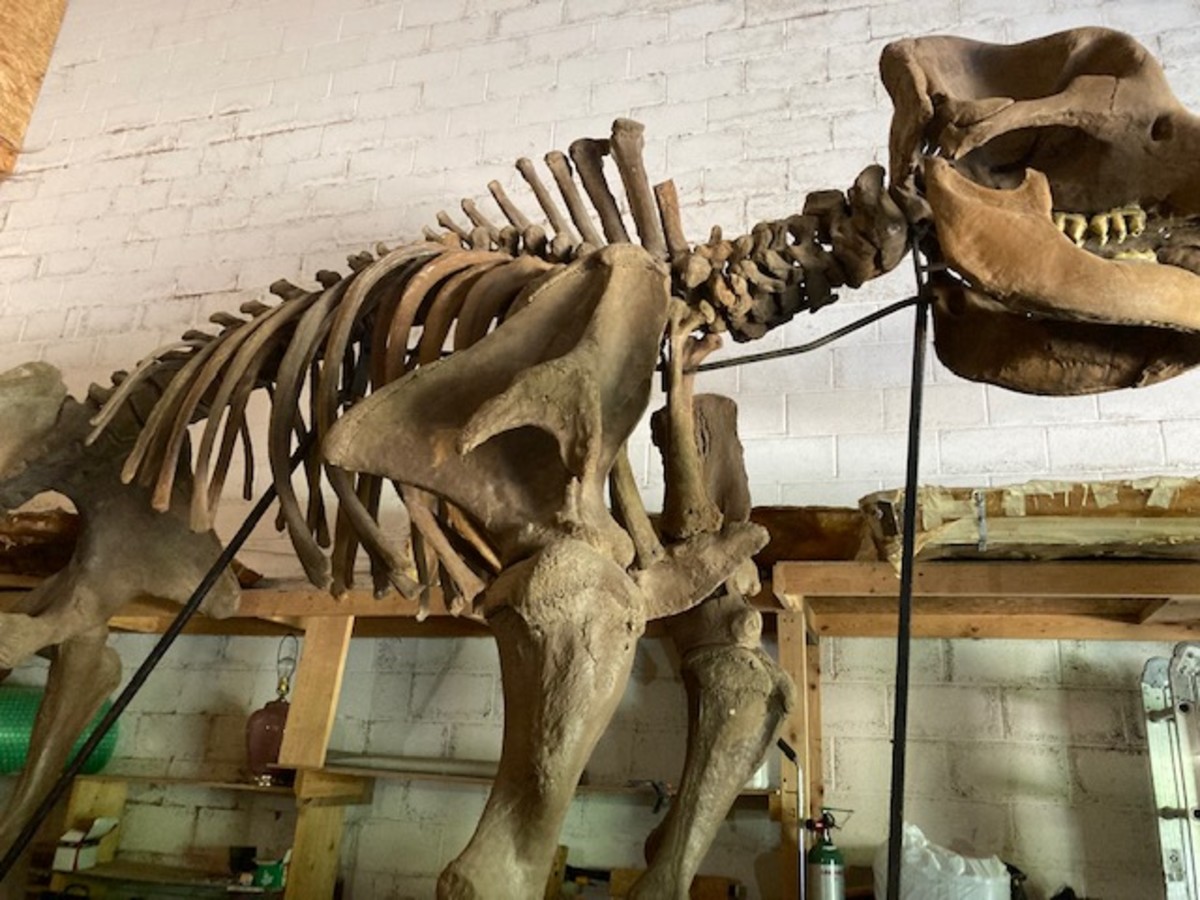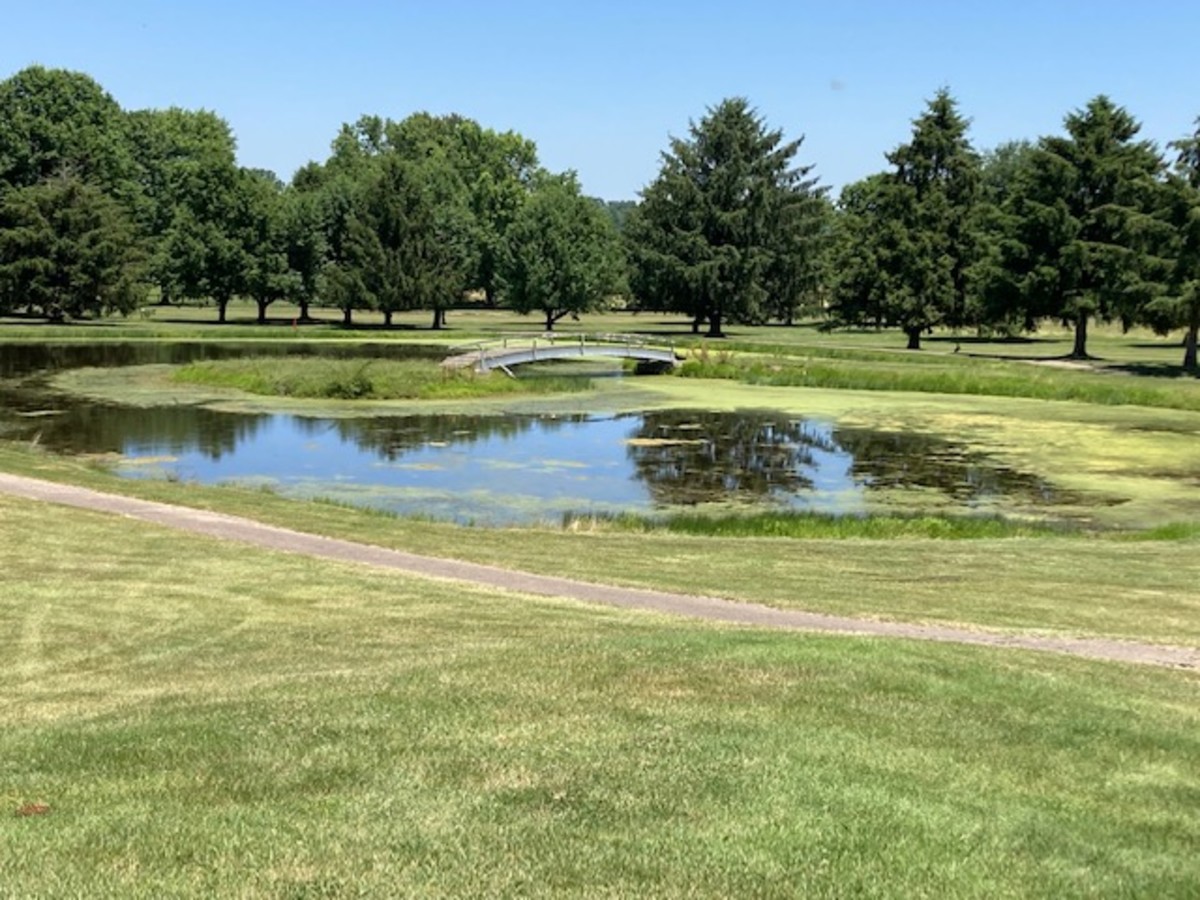This Ohio Layout Proves to Be Dinosaur of a Course

HEATH, Ohio — Mastodons and golf in the same sentence? They sound as if they go together about as well as peanut butter and petroleum jelly, water and gunpowder or Frick and Jason.
This is not late Pleistocene Era humor, when mastodons roamed what is now North America 10,000 years ago. Actually, mastodons and golf are a natural pairing at The Mastodon Golf Club, about 30 miles east of Columbus, Ohio.
That’s because a mastodon skeleton was discovered here in December 1989. Sherm Byers, owner of Burning Tree Golf Club, was excavating dirt to build a second nine holes when — gronk! He hit a mastodon skull. It turned out to be a major scientific find, notable because it turned out to be a nearly intact mastodon.
Byers sold Burning Tree early last year to Al Schultice, who upgraded the golf course, rebranded it and commemorated the historic discovery by renaming it The Mastodon Golf Club.
Why not. There was already a mastodon mural on the clubhouse’s outside wall just behind a miniature mastodon statue. (It’s mini because a real mastodon stood 14 feet tall.) There was already a replica of the skeletal mastodon head mounted on the wall inside the clubhouse so golfers can inspect its massive tusks.
Byers' family still owns a warehouse a few hundred yards away that is not open to the public. Inside, there was a full-sized mastodon skeleton replica made from the casts of Donny Mastodon’s bones. It’s an imposing, unforgettable sight. An upright mastodon, even just the skeleton, makes an elephant look like My Little Pony. And those huge curved tusks. I would love to see those in action … from a safe distance, of course.
The mastodon dig was the biggest thing that ever happened in these parts, these parts being rural Ohio and mostly farmland. The Mastodon Golf Club is located just off I-70 somewhere between Hebron (population 2,370) and Heath (population 10,847). It is close to the Dawes Arboretum and just up the road from a huge dairy farm.
If you come for the mastodon and stay for the golf at Mastodon Golf Club, you can’t avoid accidentally learning something about archaeology.
“It changed history,” Schultice says of the discovery. "It’s the most complete mastodon ever found and the only living mastodon bacteria that’s been recovered. Scientists found bones from a prehistoric sloth they didn’t even know existed.
"They were all found in a peat bog. Either the mastodon died in the bog or prehistoric men killed it and transported it to the bog. We use refrigerators to preserve our food, they used a bog because it was cool. They could butcher an animal for meat and keep it longer. That explains why a sloth and a prehistoric beaver were found there. It also stands to reason there’s probably something else down there, too."
That prehistoric caveman’s man-cave refrigerator bog is now a pond adjacent to Mastadon’s 14th hole.
The original mastodon bones were sold to a Japanese businessman and on display in a Japanese museum. Byers had replicas made of all the bones. In addition to the standing mastodon exhibit in the warehouse, a second set of mastodon bones, including tusks, is scattered around the room, unassembled and undrilled, in case you know anyone who’s really good with Legos and has a spare year or two.
Jeff Clay, 73, is a member of the golf course’s maintenance crew and has lived in the area his whole life. He remembers when the mastodon was uncovered.
"There was quite a buzz," Clay says. "Not so much at the time they found it, but the next summer when everything was going on and they started digging up other stuff. Sherm (Byers) was going to donate the mastodon to a historical society but he wanted them to build a museum for it. They didn’t want to do that. So he ended up selling it. I don’t know the exact amount but he got a pretty good penny for it."
Byers had casts made of the bones to start his own dinosaur museum on the course grounds, which was open to the public. He also had replicas of raptors and triceratops and a few others.
"It was a kind of local tourist attraction, very small," Clay says. "But if you were playing golf, you got to go through it for free. He had a pretty good business going selling replicas, too, until about 15 years ago when mechanical dinosaurs and animatronics started."

Clay isn’t that surprised prehistoric bones were found on the course in this relatively flat, unremarkable farming area.
“When the glaciers came south, this area is where they stopped and melted," he said. “This is where The Ice Age ended. I’m surprised they didn’t find more stuff in the bog. There are probably more bones out there.”
Those relics will have to wait for the next Indiana Jones. When I visited, the only thing I dug up was divots.
The golf course is great fun. It falls into the category of what I call “mom-and-pop courses.” Those are courses with limited maintenance budgets and designed by amateurs with minimal earth-moving. They are the grass roots of golf and my favorite courses to play.
Course conditions had reportedly deteriorated the last few years at Burning Tree. The new-ish Mastodon GC is in very nice shape after a lot of work. The greens have a thick thatch that makes for smooth putting.
The front nine is mostly wide open while the back nine brings in a lot of trees. The blue tees are only 6,328 yards, par 71, but the course is more fun from the whites at 5,804 yards, mainly because the par-3s are stronger than a caveman’s overlapping grip. The scorecard for the blue tees lists the five par 3s at 190, 207, 216, 162 and 210 yards, all good reasons to stick to the whites.
“From the blues, we can tip out all the par-3s to dang near 200 yards each," says Austin Phillips, Mastodon's clubhouse manager. "Like on No. 10, we can move the tee back so you’ve really got to slingshot through the trees."
That 10th hole is one of Mastodon’s most memorable. It felt like a wake-up slap in the face. The scorecard said par 3, but my keen supervision said par 4. Since it was my journalistic duty to play the tips, it's a “Yikes!” moment. It wasn’t the distance, which was 208 this day, but the hallway of trees I had to hit through and mainly, the large tree on the right that was going to force me to hit a fade, not my strength. I didn’t hit a fade, I hit a not-on-purpose low bullet that somehow went clean through the big tree’s branches and finished just off the green’s right side, from where I made an easy par. Lucky is a good strategy that’s hard to execute. But wow, what a hole.
Here are the some other notable spots I visited at The Mastodon:
5th Hole: A straight shot along the outer property line, featuring out of bounds down the left side. A large pond squats in the middle of the par-5 hole. I manned up and launched a massive drive over it. Correction, my tee shot rolled to a stop short of the water. Oh, right. I forgot ... I’m old. Well, that pond is well-placed for big hitters and a second-shot dilemma for real short hitters.
8th Hole: The green sits at the edge of a scenic pond. It’s a short par 4, 343 yards, wide open, and a nice birdie chance. The pond intimidatingly appears to lap at the green’s back edge, but it’s what old-time comedian Norm Crosby, whose schtick was misusing words, would call “an optical delusion.” That’s an illusion. A delusion was the idea I was going to make birdie there.
9th Hole: A strong par 4 that curls right. It is 438 yards and a large, multi-trunked oak tree in the right rough blocks access to the green to any luckless golfer dumb enough to hit a drive up the right side — me, in other words. I had a better chance of making a layup against Dikembe Mutombo than of getting an approach shot on the green. One well-placed tree makes this hole fun … and an easy bogey.
14th Hole: This is the actual mastodon hole and is as imposing at its namesake. It is 441 yards, the fairway bends left and drops to a lower level. The big pond where the mastodon was found is adjacent to the green, where a bridge donated by a local historical society commemorates the spot.

The hardest part of this hole is the second shot. The green is wedged between two other ponds and mostly hidden by a big tree guarding its left side. So there is not much to aim at except the green’s front edge. I did that and successfully made a par. I also played a ball from the shorter white tees but pulled it left and hit a tree. From there, I chipped one down the fairway, or so I thought. When I got to where the fairway dropped off and veered left, I discovered I had just laid up straight into the mastodon pond. Someday, an archaeologist will find a mysterious artifact labeled “Srixon.”
17th Hole: The hole runs parallel to the 14th but is even more unusual. It’s a par 5 of only 460 yards. There’s a large raised pond on the left — a water reservoir for the course’s other ponds. The green is way left, beyond the reservoir lake, but sits considerably lower. All I could see from the fairway was the top of the flagstick even though I was only 155 yards away. Playing semi-blind, I was able to get a 7-iron shot on the green and then totally gag on a 25-foot eagle putt. I’ll feel more comfortable on the 17th — and some other holes — the next time because now I know where I’m going.
18th Hole: The closer is a nightmare come to life. For starters, it’s a par 3 with an island green. But it’s not in the middle of pond like the famous one at TPC Sawgrass. This one has a large pond right of the green and a significant moat around the rest. That doesn’t sound so bad, right? Wrong. This par 3 plays 190 yards from the white tees, 210 from the blues. It’s a bad-ass, final-hole score-wrecker, the kind of hole you spend the whole round dreading.
The good news is that the green is reasonably wide and there is additional fairway/rough all the way around, enough to maybe snag an errant shot and keep it out of the moat. Maybe.
Or maybe not. I hit a hybrid from the blue tees and found the lower right edge of the green. Curiosity called for a second attempt. That one drifted right and apparently drowned in the pond. I’m calling it a suicide.
Back to the nightmare. My ball was on a narrow lower ledge that forced me to putt up a large slope toward the pin. I holed my second putt from 10 feet. Is this a good finishing hole or simply pure, twisted evil? You make the call.
The gigantic mound beneath the middle of the green made me wonder, though. Was something buried beneath this green? Like another mastodon or two? Nahh. There couldn’t be. Could there?
Just in case, does anyone have an email address for Indiana Jones?
